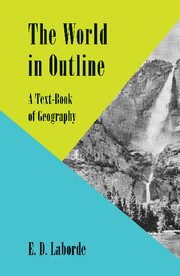Book contents
- Frontmatter
- Preface
- Contents
- PLATES
- PART I EUROPE
- PART II ASIA
- PART III AFRICA
- PART IV NORTH AMERICA
- PART V SOUTH AMERICA
- PART VI AUSTRALIA, NEW ZEALAND, AND THE PACIFIC ISLANDS
- Australia
- Human Geography
- New Zealand
- Human Geography
- The Pacific Islands
- Appendix: An Outline of Physical Geography
- Index of Place-Names
- General Index
Australia
from PART VI - AUSTRALIA, NEW ZEALAND, AND THE PACIFIC ISLANDS
Published online by Cambridge University Press: 05 June 2016
- Frontmatter
- Preface
- Contents
- PLATES
- PART I EUROPE
- PART II ASIA
- PART III AFRICA
- PART IV NORTH AMERICA
- PART V SOUTH AMERICA
- PART VI AUSTRALIA, NEW ZEALAND, AND THE PACIFIC ISLANDS
- Australia
- Human Geography
- New Zealand
- Human Geography
- The Pacific Islands
- Appendix: An Outline of Physical Geography
- Index of Place-Names
- General Index
Summary
Position and Size. Australia lies between the Indian and Pacific Oceans and is in the latitude of North Africa. As it covers 40° of longitude, it has for convenience’ sake been divided into three belts of standard time: (1) the eastern belt, 10 hours ahead of Greenwich, (2) the central belt, 9½ hours ahead, and (3) the western belt, 8 hours ahead. It has an area of about three million square miles and is the smallest of the continents. This and its isolation have sometimes caused it to be spoken of as the island-continent. It shares with the southern extremities of South America and South Africa the distinction of being one of the three considerable land masses in the southern hemisphere, and in consequence it has many points of likeness to those two countries. It is, however, unlike them in having its greatest length from west to east, while they taper towards the south.
Build and Relief. The nucleus of Australia is the great crustal block which forms about half the continent. Likenesses in the nature and arrangement of the rocks have led to the belief that this part of the continent was once joined to India, Africa, and the Highlands of Brazil and Guiana by vast stretches of land which formed the mighty land mass of Gondwana Land, but which have since foundered beneath the sea. It forms a tableland with an average height above sea-level of some 1200 feet. The southern edge falls away sharply to the sea in cliffs 200 feet high, but on the west the drop is more gradual and there is a narrow strip of coastal lowland. The top of the tableland is roughened by lines of worn hills, of which the Macdonnell and the Musgrave Ranges are the most important. Much of the surface drains inland into salt lakes ranging in size up to Lake Amadeus. The Nullarbor (= ‘treeless’) plains of the south, which are made of limestone, are irretrievably barren, while farther north patches of bare rock are intermingled with poor steppe dotted with tufts of spinifex or clumps of mulga scrub. In the northwest there is an area of true sand desert, but it is not as large as it is usually said to be.
- Type
- Chapter
- Information
- The World in OutlineA Text-Book of Geography, pp. 426 - 451Publisher: Cambridge University PressPrint publication year: 2013



